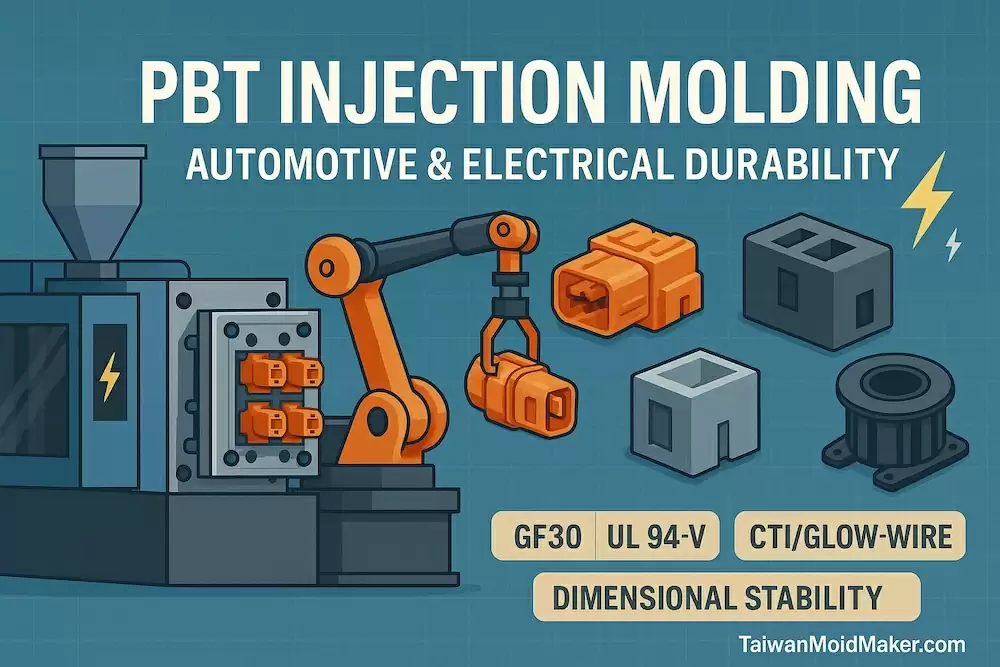PBT Injection Molding for Automotive & Electrical Component Durability
PBT Injection Molding for Automotive & Electrical Component Durability

Explore PBT Injection Molding for Automotive & Electrical Component Durability
Polybutylene terephthalate (PBT) is a high-crystallinity engineering thermoplastic known for dimensional stability, electrical insulation, chemical resistance, and fast cycles. With the right grade—glass-fiber, flame-retardant, impact-modified—PBT delivers rugged parts for under-hood, powertrain, connectors, relay bases, sensors, motor housings, EV charging components and more.
Why Choose PBT for Auto & E/E?
-
Dimensional stability: low moisture uptake → tight tolerances over time (less drift than PA6/PA66).
-
Electrical performance: high CTI/PLC options, good dielectric strength; FR grades achieve UL 94 V-0 and glow-wire compliance.
-
Heat & creep resistance: withstands continuous service in warm engine bays and live electrical environments.
-
Chemical resistance: fuels, oils, coolants, cleaners; good hydrolysis-resistant grades available.
-
Cosmetics + speed: high crystallinity yields short cooling times and crisp surfaces—great for housings and visible parts.
PBT Grade Map (Pick by Requirement)
| Grade | Typical Use | Key Benefits | Notes |
|---|---|---|---|
| Unfilled PBT | Thin covers, coil bobbins | Fast cycles, nice surface | Lower stiffness than GF grades |
| GF20/30/40% | Brackets, carriers, motor housings | High stiffness/HDT, low creep | Manage fiber orientation to control warp |
| FR (halogen-free or brominated) | Connectors, relay bases, EV components | UL 94 V-0, CTI up to high levels, glow-wire | Slight cycle/flow changes vs non-FR |
| Impact-modified | Clips, snaps, latches | Toughness at low temperatures | Balance vs stiffness |
| PBT/PC or PBT/PET blends | Cosmetic housings needing impact | Surface quality + toughness | Adjust mold temp for best surface |
| Laser-markable / UV-stabilized | Traceable E/E parts, exterior trim | Readability & weathering | Specify color/contrast targets |
High-Value Applications
-
Automotive: sensor & ECU connectors, relay/fuse boxes, fan shrouds, pump/valve housings, gear-motor covers, mirror carriers, lamp sockets, charge-port parts.
-
Electrical/Electronics: terminal blocks, coilformers, switch bodies, circuit breakers, contact carriers, HV orange plug bodies, appliance connectors.
Design Rules That Keep PBT Parts Robust
-
Walls: 1.5–3.0 mm typical; keep uniform to limit sink/read-through.
-
Ribs: 40–60% of adjacent wall; add fillets to diffuse stress.
-
Draft: ≥1.0–1.5° textured; ≥0.5° polished; add more for deep ribs.
-
Bosses: ID ≈ 60–70% OD; fillet bases; tie into walls with ribs.
-
Gates: for GF grades, align flow with load paths; use fan/film on skins to reduce weld visibility.
-
Inserts/metal contacts: design poka-yoke nests; consider pre-heat for bond quality and stress reduction.
-
Creepage/clearance: follow your voltage class—define CTQ distances on drawings.
Processing Window (Typical Starting Points—tune via DOE)
| Parameter | Range* | Notes |
|---|---|---|
| Drying | 120 °C for 2–4 h (≤0.02% moisture) | Moisture causes hydrolysis → brittleness/splay |
| Melt Temp | 240–260 °C (FR blends may vary) | Avoid long residence to prevent degradation |
| Mold Temp | 60–100 °C (80–120 °C for cosmetics/GF) | Higher temps improve surface & crystallinity |
| Injection Speed | Medium–High | Helps knit strength on thin features |
| Pack/Hold | Sufficient to control sink/voids | Beware over-packing at bosses |
| Shrinkage | Unfilled ~1.2–2.0%; GF ~0.2–0.7% | Anisotropic with GF → gate/cool symmetrically |
*Actual settings depend on grade, geometry, and hot-runner choice.
Tooling & Cell Options from Our Network
-
Valve-gated hot runners (natural/engineered balance) for multi-cavity connectivity parts.
-
Conformal-cooled inserts or high-conductivity cores at hot spots → shorter cycles, flatter parts.
-
Inline automation: insert loading, laser mark, vision seam/vestige control, torque/leak tests.
-
MES dashboards: live OEE, CpK at CTQs, genealogy for PPAP or device history records.
Quality & Compliance (Auto + E/E)
-
APQP/PPAP Level 3 readiness (DFMEA/PFMEA, control plan, MSA, capability).
-
Electrical: CTI/PLC targets, Glow-Wire (GWIT/GWFI), RTI as required.
-
Material: RoHS/REACH, halogen-free options, HV orange color control for EV standards.
-
Metrology: FAIR + CMM/blue-light scans; custom fixtures for warpage & pin dimensions.
-
Cosmetics: ΔE color thresholds, gloss/orange-peel mapping under defined lighting.
PBT vs. Alternatives (Quick Buyer’s View)
| Attribute | PBT | PA66 | POM | PC/ABS |
|---|---|---|---|---|
| Moisture uptake | Low (stable dims) | High (pre-dry; dims drift) | Very low | Low–Med |
| Electrical insulation/CTI | Excellent | Good | Good | Good |
| Chemical/oil resistance | High | Med–High | Very High | Med |
| Heat resistance (HDT) | High (↑ with GF) | High | Med | Med |
| Surface/cycle speed | Fast, crisp | Med | Med | Med |
| Toughness (unfilled) | Med | Med–High | Med | High |
Typical Outcomes from Optimized PBT Cells
| KPI | Before (Generic Cell) | Optimized PBT Cell |
|---|---|---|
| Cycle (GF30 connector body) | 18.5 s | 14.5–15.8 s |
| Warpage (70 mm housing) | 0.35 mm | ≤0.18–0.22 mm |
| Cosmetic rejects | 2–3% | ≤1% |
| CpK at pin-to-pin (CTQ) | 1.33 | ≥1.67 |
Representative; results depend on resin and geometry.
RFQ Template (Copy/Paste)
Subject: RFQ – PBT Injection Molding (Automotive/Electrical)
Attachments: STEP/IGES + 2D drawing with CTQs and creepage/clearance
-
Part name / revision:
-
Annual volume & first PO qty:
-
PBT grade targets: (GF %, FR/halogen-free, CTI/PLC, glow-wire, UV, color—e.g., HV orange)
-
Dimensional hotspots & tolerance bands (pin-to-pin, flatness/warp):
-
Cosmetic class & texture: (A/B/C, SPI code, ΔE tolerance)
-
Special features: (inserts, overmold, laser-mark window)
-
Inspection pack: (FAIR, CMM, electrical tests, PPAP level)
-
Packaging/logistics: (returnable trays, label spec, EDI/ASN)
-
Target dates (T0/T1/PPAP/SOP) & Incoterms:
-
Known risks (thin walls, long flow, weld areas):
Related Services & Quick Links
-
Custom Mold & Design Maker – DFM & CAE for PBT gating/cooling
https://www.taiwanmoldmaker.com/product/custom-mold -
Mold Service – aluminum, hybrid, and full steel tooling
https://www.taiwanmoldmaker.com/product/mold-service -
Injection Mold – materials & processes overview
https://www.taiwanmoldmaker.com/product/injection-mold -
Molding – automated cells with MES traceability
https://www.taiwanmoldmaker.com/product/molding -
Customer Examples – case snapshots and results
https://www.taiwanmoldmaker.com/product/customer-examples
Call to Action
Building durable automotive or electrical parts that must pass CTI/glow-wire and stay dimensionally true? Send CAD and requirements to receive a 48-Hour DFM & Cost Pack with gating plan, cooling concept, and qualification path.
Request an Instant Quote → https://www.taiwanmoldmaker.com/contact








